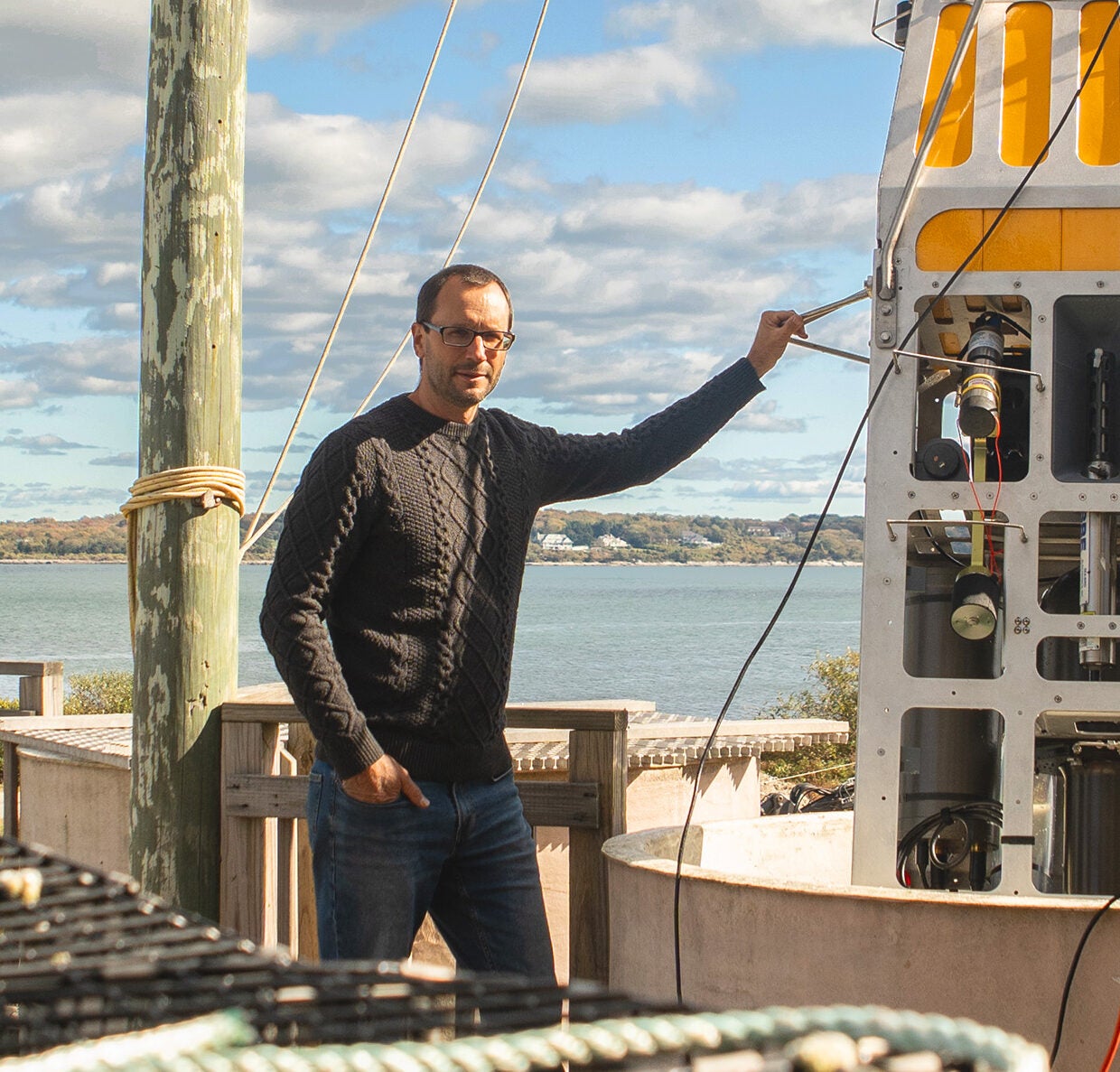- Professor of Oceanography
- Marine Geology and Geophysics
- Phone: 401.874.6115
- Email: croman2@uri.edu
- Office Location: 111 Horn
- Website
Biography
On prominent display in the lobby of GSO’s flagship building during the 2014 Commencement period was a curious bright yellow, flat-fish shaped device that bore something akin to fins on each side and a small propeller at the rear.
There was no sign describing the exhibited device but a nearby video kiosk provided the necessary information–the device was called a Wire Flyer and it represented one of the newest accomplishments of Dr. Christopher Roman, an oceanographer and ocean engineer, and his team of collaborators.
Roman came to GSO in 2006 after earning his doctorate from MIT and Woods Hole Oceanographic Institution to assist the celebrated Ballard Group (an organization that supports the efforts of Dr. Robert Ballard and focuses on ocean mapping, archeology and geological exploration).
“I have two lives here,” says Roman.
With a background in robotics he helps the Ballard group with deep and acoustic mapping tasks that result in high resolution images of the seafloor. This work has taken him all over the world—usually two months out of the year he is at sea. With Ballard, Roman has been to such places as Turkey, the Black Sea, the Aegean Sea, the Mediterranean, the Gulf of Mexico, the Lesser Antilles, the Southern Caribbean and Cyprus.
Roman’s other “life” is exploring coastal areas with shallow water “floats” that carry an array of instruments designed to measure such things as water density, currents, water clarity, plankton layering, habitat assessment and topography. These instruments are different from the deep-water types that are deployed in areas where changes are relatively slow. In contrast, changes are rapid and often turbulent in coastal areas.
While such coastal devices are autonomous, they are not left completely on their own, says Roman. “We are out there too on a ship—it’s like quasi-babysitting.”
Technology is quite different today than it was when he began his career, he says, noting that the batteries are much better now and the computers are much smaller, making it easier to record more data over a longer span of time.
A native of New Jersey, Roman said he was always interested in robotics and ocean science and ocean engineering allowed him to combine the two. At GSO, he has a lab where he, his students and colleagues assemble the instrumentation. Since the gear usually involves the creation of components that have to be made to fine tolerances, much of the machining is sent out to a select group of shops.
Funding for his work comes from a variety of sources. The students that he mentors are interested in computer work/data processing. “I try to give the students an engineering problem linked to a science problem.”
Roman was part of the team of GSO scientists who went to Antarctica in 2013 to study the feeding habits of krill which somehow manage to get nourishment despite the bleak winter season. They will revisit the area in the Antarctic “spring.”
One of Roman’s most interesting projects was the development of the Wire Flyer that is towed by a ship but is designed to quickly slide up and down in the water column, taking measurements en route. The sensors on the Wire Flyer enable researchers to garner a “shower curtain slice of the ocean,” he says. In 2013 the device was successfully tested and in late 2014 it will be deployed on a research project, looking for methane seeps in the Gulf of Mexico.
The Wire Flyer is just one of the novel things going on at GSO, he said, adding that he values “the good community that has interesting projects.”
Research
Climate change, Coastal and estuarine health, Coastal and estuarine physical oceanography, Coastal circulation and mixing, Coastal water circulation, Current measurements, Engineering, Estuarine circulation and mixing, Estuarine oceanography, Hypoxia, In-situ sensing, Instrumentation, Observational physical oceanography, Observations of mixing and circulation, ROV sensing, Underwater archeology
My research interests focus on developing sensing systems and methods for acoustic and photographic seafloor mapping. This work involves underwater and surface vehicle mechanical and control system design, navigation data processing, acoustic instrumentation and signal processing, image processing and mapping algorithm development. I also have a joint appointment in the URI Department of Ocean Engineering. Reently, at the Graduate School of Oceanography, with support from the Champlin Foundations, we have developed a free-swimming autonomous surface vessel (ASV) as an educational sampling tool for undergraduate education, coastal marine research, and public outreach activities in the Narragansett Bay watershed. The ASV is a self-propelled robotic watercraft that can be remotely controlled or programmed to run self-guided missions and collect data with a suite of environmental sensors. New teaching materials, field-based activities, and courses will allow URI students from various disciplines to participate in experiential learning and research. Students using the ASV will learn the basic logical and quantitative skills necessary for making field measurements using robotic tools while developing a scientific understanding of the local marine environment
Education
Ph.D. Ocean Engineering, Massachusetts Institute of Technology / Woods Hole Oceanographic Institution, 2005
M.S. Mechanical Engineering, University of California, San Diego, 1999
B.S. Mechanical Engineering, Virginia Polytechnic Institute and State University, 1997
I have also taught the following courses: Modern oceanographic imaging & mapping techniques – OCG 594. The Ocean Planet-Section on Ocean Exploration – OCG 110.
Selected Publications
Please visit my personal/lab page for a complete listing. Thanks.
http://www.gso.uri.edu/cnr/www/about.php

